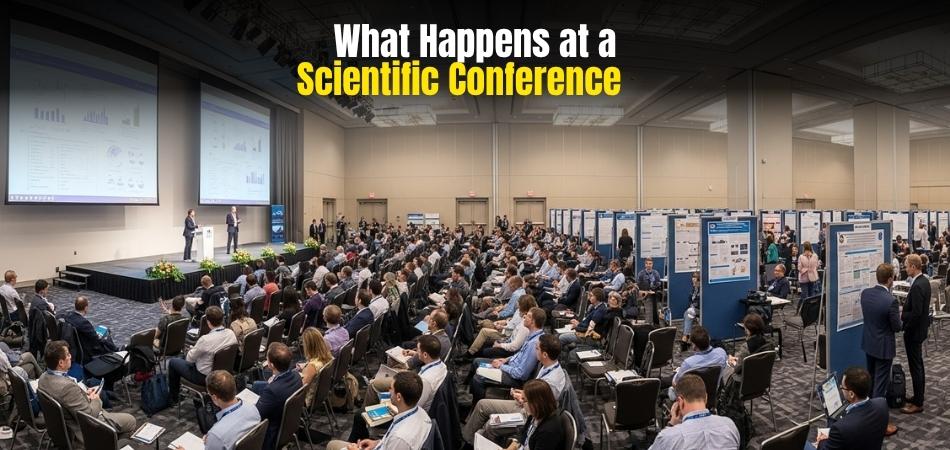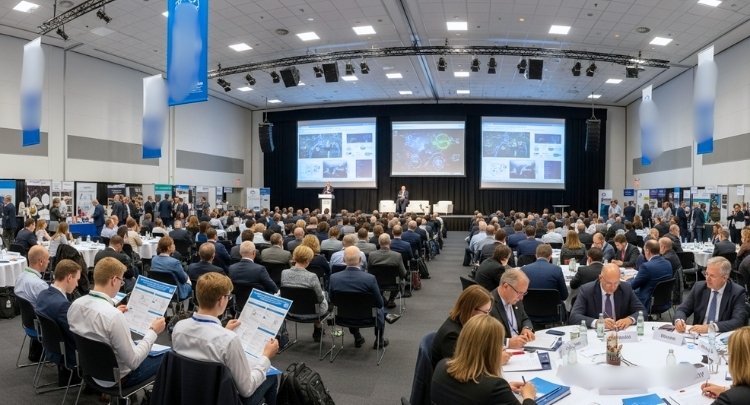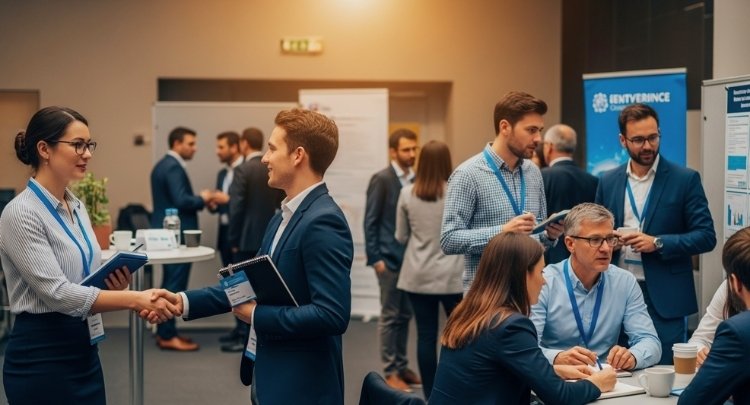People come together to share new ideas and discoveries at a scientific conference. Researchers give talks, show posters, and join group discussions. There are workshops, speeches, and times to ask questions. It’s also a chance to meet others, make friends, and learn about the latest science. So, what happens at a scientific conference?
It’s where experts present their work, answer questions, and connect with others in simple, open ways. Some events are held in person, some online, and some mix both. These gatherings make learning and sharing easy for everyone.
In the rest of this article, you’ll see more about what makes conferences so useful and exciting
What Happens at a Scientific Conference?
Scientific conferences bring researchers, professionals, and students together for learning, sharing, and networking. Each day follows a structured schedule filled with unique activities. Every moment is designed to encourage new ideas and connections across different fields. Here’s what usually happens during a scientific conference:
Keynote Speeches and Plenary Sessions
- Well-known experts deliver long talks that outline broad themes and current challenges, guiding the audience toward fresh perspectives.
- Such sessions attract all attendees into one space, creating shared moments of inspiration and collective academic curiosity.
- Multiple speakers often join panel discussions, debating issues, answering questions, and showcasing different ideas with rich explanations.
- These talks usually run 30 minutes to 90 minutes, setting the mood for deeper discussions and specialized activities.
Oral Presentations and Breakout Sessions
- Researchers give shorter talks highlighting findings, usually ten to thirty minutes, supported by slides, figures, and important results.
- Sessions are divided by themes, running simultaneously, letting attendees pick topics that match their personal learning interests.
- Presenters sometimes critique other assigned papers, sparking dialogue, encouraging constructive thought, and strengthening shared research development.
- These sessions encourage interaction, allowing people to clarify points, debate results, and generate deeper understanding among peers.
Poster Sessions
- Researchers present work visually on large posters, while standing nearby to explain, engage, and answer detailed questions.
- This format creates direct interactions, helping attendees hold meaningful one-on-one conversations, particularly helpful for younger researchers.
- Posters highlight visuals, graphs, and summaries, making complex studies easy to understand without lengthy presentations or heavy detail.
- Attendees move freely, exploring diverse projects, picking posters of interest, and asking researchers about clear practical insights.
Workshops, Roundtables, and Training Sessions
- Participants join hands-on activities that teach new skills, from lab techniques to software tools, in interactive sessions.
- Roundtables invite open discussion, creating collaborative spaces where shared ideas and questions spark useful research directions.
- Some events feature live demonstrations, such as forensic experiments, giving attendees applied experience beyond written or spoken formats.
- Informal, unconference-style meetings without fixed agendas encourage spontaneous exploration, making creativity flourish across professional fields.
Vendor Booths and Exhibits
- Companies showcase new products, technology, and services while engaging researchers in practical discussions about possible collaborations.
- Attendees explore exhibits, receive promotional gifts like mugs or pens, and discover resources from publishers and organizations.
- Booths also provide career opportunities, with company representatives explaining roles, expectations, and ongoing professional development possibilities.
- Networking at these exhibits often leads to industry contacts, helping researchers build bridges between academic work and industry needs.
Networking and Social Events
- Lunches, coffee breaks, and receptions provide natural chances to meet new colleagues, share ideas, and discuss projects.
- Organized dinners, city tours, or cultural activities offer memorable ways to strengthen friendships and deepen professional trust.
- Many societies also host business meetings during these events, encouraging future plans, group decisions, and project collaborations.
- Countries like Canada, the United States, Germany, and Japan host global events; examples include upcoming conferences in Canada.
What Can You Expect From Scientific Conferences As Participants?
Scientific conferences give participants a mix of learning, networking, and sharing opportunities. From keynote sessions to poster presentations and interactive discussions, every activity offers a chance to grow. Here are the main experiences you can expect as a participant:
Big Talks
Most conferences begin with big talks by well-known experts who share fresh ideas about their fields. These sessions set the mood and give you a big picture of the latest research. You get to hear inspiring stories and real-life experiences. Listening to these speakers can make you feel motivated to dream bigger in your own work.
Small Presentations
Smaller talks usually focus on specific projects where researchers explain their results in detail. These sessions are easier to follow because they use slides, graphs, or pictures. You can ask questions directly and understand the work better. Attending these talks helps you discover new subjects that might interest you later.
Poster Displays
Poster displays are colorful and filled with charts, pictures, and short points. Researchers stand beside their posters and talk about their work with anyone interested. You can walk around, pick posters that look interesting, and ask questions. This is one of the easiest ways to learn directly from researchers.
Hands-on Sessions
Workshops and training events give you a chance to try things for yourself. You might learn how to use new tools, programs, or methods. These sessions are usually interactive, so you stay involved and alert. It feels less like a lecture and more like practicing something useful.
Exhibits and Stalls
Companies and organizations often set up stalls to show new machines, books, or even software. You can explore different products, take free goodies, and talk to people who work there. These stalls also tell you about future study or work options. Sometimes, you even find ideas for your career path.
Social Time
Conferences are not only about science; they also include breaks, lunches, and even fun evening events. These moments give you a chance to relax and talk casually with other people. Many friendships and future projects begin during these informal chats. You never know how a simple conversation can turn into something important.
Planning Your Day
Most conferences have many sessions happening at the same time, so planning matters a lot. Attendees usually look at the program to decide what to attend. If you plan well, you won’t miss the sessions most useful to you. This makes your experience smoother and more enjoyable.
Who Should Attend a Scientific Conference?
Scientific conferences gather people from many backgrounds who share an interest in science, learning, and professional growth. These events give valuable knowledge and networking opportunities. Attendees return with new ideas, better skills, and stronger academic or career connections that help shape their future. The following groups are among those who benefit most from attending scientific conferences:
Students and Learners
Young students who enjoy science can benefit greatly from attending these events filled with talks and interactive discussions. They listen to experts explaining new research and gain knowledge beyond what is taught in classrooms daily. Many students also present posters or small projects, which helps build confidence in communication skills. Meeting peers from different schools or countries creates new friendships and motivates them to explore broader fields of science.
Researchers and Scholars
Active researchers attend conferences to present their findings and learn about other people’s work across related fields of study. They share oral presentations, posters, or participate in roundtable sessions that encourage debates and constructive discussions about important issues. Conferences give them recognition, ideas, and inspiration that keep their scientific efforts strong and forward-moving.
Teachers and Professors
Educators need to stay updated with current research, new teaching methods, and discoveries that improve their lessons significantly. By hearing from leading experts, they collect useful examples and real stories to bring back into classrooms and lectures. Attending conferences strengthens their ability to inspire students and keep science learning fresh, exciting, and constantly relevant.
Professionals and Industry Experts
People working in industries such as healthcare, technology, or environmental science attend for practical learning and networking. They see new machines, software, or technologies that companies introduce at exhibit booths and vendor stalls. Industry professionals also attend to find new collaborations and discuss potential jobs with academic researchers or organizations. This makes conferences important spaces for exchanging ideas between academic research and real-world professional applications.
Society Members and Organizers
Many scientific societies and organizations hold meetings at conferences to plan future projects and elect committee leaders. Members join to stay involved with community activities and contribute to their field’s collective growth. Discussions often focus on challenges like funding, training, and even reasons for expensive scientific conferences that affect participation. Attending gives members influence, stronger connections, and opportunities to shape the direction of their scientific community.
Early Career Scientists
Young scientists beginning their careers attend to share their first research papers, learn, and connect with experienced professionals. They receive feedback that sharpens their work and helps them identify new directions for further exploration. Networking during social events can also lead to job offers or research partnerships. These early steps make conferences important milestones for building long-term scientific careers.
Policymakers and Advisors
Government officials and policy advisors sometimes attend to understand how research outcomes can shape rules, health guidelines, or environmental actions. They hear directly from scientists about pressing issues, new solutions, and data-driven insights that affect entire communities. Attending conferences allows them to make informed decisions with real scientific support. This builds stronger trust between science, government, and society, creating progress that benefits everyone.
How Do You Find a Scientific Conference for You?
Choosing the right science conference can feel big, but it gets easier with a simple plan. You only need clear goals, a few smart searches, and honest checks on time and money. Follow these seven steps to find an event that fits you well:
Step 1: Know Your Goal
Start by writing what you want from the event: learning, presenting, jobs, or meeting mentors. Think about your field and the level you need, like beginner, mixed, or advanced. Decide if you prefer research focus, career help, or hands-on skills. This choice guides every later decision and saves time.
Step 2: Choose Topics and Format
Next, choose your main topics and pick formats you enjoy. Some events run talks, posters, or workshops; others mix in training and panels. Decide if you want in-person, online, or hybrid, depending on travel and comfort. A good match keeps you engaged and helps you learn more.
Step 3: Search Trusted Sources
Then search trusted places like society websites, university pages, and well-known conference calendars. Use clear keywords with your field, city, and dates to narrow results fast. Ask teachers or coworkers for tips, and check past attendee comments. Make a short list with links, deadlines, and costs in a simple table.
Step 4: Check Timing and Place
After that, look at the timing, location, and time zones. Check for clashes with exams, family plans, or big project deadlines. Think about visas, weather, and travel routes if the event is abroad. If online, confirm session hours match your schedule so you can attend live.
Step 5: Compare Costs and Value
Also, compare fees, travel, food, and a basic budget for gear or printing. Search for student prices, scholarships, and volunteer roles that cut costs. Read what is included, like meals, workshop access, or recordings, so youcan judge fair value. Pick the option that gives strong learning and contacts without stressing your wallet.
Step 6: Review Agenda and Speakers
Before you book, read the program and study the speakers. Look for clear tracks, session titles, and time for questions. Prefer events with diverse voices and practical sessions that fit your goals. If posters and training matter to you, confirm the schedule supports them well.
Step 7: Plan Submissions and Travel
Finally, check deadlines for abstracts, competitions, or travel grants. Prepare a short summary, a simple slide deck, or a neat poster early. Book transport and rooms early for better prices, and set reminders for key dates. Share your plan with a friend or mentor so someone can keep you on track.
Tips to Help You Network Effectively at a Scientific Conference
Conferences give you a chance to meet people who share interests and can influence your growth. Every conversation helps you learn, build confidence, and maybe even spark future projects. Follow these tips to make networking smoother, friendlier, and more meaningful:
Prepare Beforehand
- Review the conference program early, highlight sessions and speakers, and set simple goals for meaningful conversations with attendees.
- Practice short introductions about yourself, mention your interests, and keep friendly questions ready to start comfortable discussions.
Start Small
- Begin with casual chats during coffee breaks, using relaxed comments to ease into deeper professional conversations later.
- Look for familiar faces from online groups or past classes to break the ice and lower stress naturally.
Listen Actively
- Focus on the speaker’s words, make eye contact, and ask follow-up questions showing respect for their shared insights.
- Avoid interrupting, give supportive nods, and let the conversation flow smoothly while gently steering toward useful topics.
Ask Good Questions
- Prepare thoughtful questions that connect with your research interest and invite detailed answers beyond short responses.
- Make questions open-ended, allowing the other person to expand their points, encouraging smoother and more engaging dialogue.
Take Useful Notes
- Write short details about people you meet, including names, topics, and unique points mentioned during conversations.
- During lectures or posters, remember that taking notes at a scientific conference helps you recall key moments later.
Join Social Events
- Attend dinners, tours, or casual mixers, as these relaxed spaces make professional talks easier and less stressful.
- Participate in group activities, where laughing and sharing informal moments can naturally build stronger professional bonds.
Follow Up Later
- Send a short email or message after the event, thanking people and reminding them about your conversation.
- Share articles, papers, or helpful links when reaching out again, showing real interest in continuing the connection.
FAQs About Scientific Conference Sessions and Activities
Scientific conferences bring together researchers, students, and professionals in one space. They mix talks, workshops, posters, and social time, making them exciting and useful. Here are eight frequently asked questions that help explain what happens at these events.
How Long Does a Scientific Conference Usually Last?
Most conferences last between two and five days, depending on their size and focus. The schedule includes keynote speeches, presentations, workshops, poster sessions, and social events. Attendees plan carefully to balance sessions with breaks, networking, and personal learning goals.
What Role Do Keynote Speakers Play?
Keynote speakers often set the tone for the entire event by highlighting important themes and inspiring attendees. Their talks give perspective on current challenges, new directions, or emerging fields. These sessions usually draw all participants together in one space.
Are There Career Opportunities at Conferences?
Yes, many conferences include job fairs, mentoring sessions, and industry booths. These spaces allow attendees to meet recruiters, explore roles, and discuss future possibilities. Building personal connections often leads to internships, collaborations, or valuable advice from experienced professionals.
How Do Poster Sessions Work?
Poster sessions are interactive spaces where researchers present projects on large boards. Attendees walk around, ask questions, and have one-on-one discussions. This setting allows presenters to explain details informally, making it easier for others to understand complex studies.
Do Conferences Include Hands-on Learning?
Many conferences include workshops or training sessions focused on practical skills. These may involve demonstrations, software tutorials, or experiments. Participants actively take part instead of just listening, which makes the experience memorable and useful for both research and careers.
Can Students Participate in Conferences?
Students not only attend but also present research, posters, or short talks. Conferences give them a platform to practice public speaking, gain feedback, and meet experts. The experience helps them build confidence, knowledge, and networks for future academic growth.
What Happens During Social Events?
Conferences often host dinners, receptions, or tours alongside academic sessions. These informal settings encourage conversations in a relaxed way. Attendees form new friendships, discover collaborators, and build strong professional ties while enjoying cultural or fun activities beyond the talks.
How Do Attendees Manage Busy Schedules?
Programs often run multiple sessions at the same time, requiring careful planning. Attendees use conference schedules to select topics most relevant to their interests. By balancing talks, breaks, and networking, they make the most of each conference day.
Concluding Thoughts
A scientific conference is not only about talks and posters, it is about people meeting and learning together. You can listen to experts, see new research, and join small sessions where questions and answers feel simple. Many friendly conversations during breaks or meals lead to new friends and possible future work.
When we think about what happens at a scientific conference, it is clear that these events give more than lectures. Students, teachers, and professionals all find useful ideas and build strong links. Leaving with fresh knowledge, simple skills, and helpful contacts makes the whole experience valuable and exciting.








